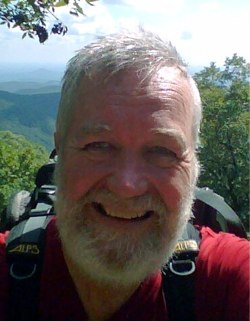[caption id="attachment_952" align="alignleft" width="250"] Clifford Andrew (PGP-84) hiking on the Appalachian Trail in North Carolina (Photo posted with permission)[/caption]
Clifford Andrew (PGP-84) hiking on the Appalachian Trail in North Carolina (Photo posted with permission)[/caption]
This is a guest blog post from Clifford G. Andrew, M.D., Ph.D., Duke University School of Medicine, Class of 1972. Adjunct Assistant Professor of Neurology, Johns Hopkins University and PGP-84.
As a practicing physician, health protagonist and amateur genealogist, I have been an enthusiastic participant in the Personal Genome Project since enrolling in October 2010. This past fall, I returned to my alma mater, Duke University, for my Medical School Class of 1972 40th reunion. As in the past, we had set up a "mini-symposium" for discussion of various medical topics of interest to lay persons including spouses and families of our graduating class.
I decided that it would be appropriate to give a presentation on PGP to our group. As it turned out, our reunion was taking place within weeks after Robert Lefkowitz was announced as the 2012 Nobel Laureate in Chemistry for his research while we were at Duke on "G-Protein-Coupled Receptors." (1) In effort to put my talk in some context, I went back and did some research on previous Nobel laureates, and found to my surprise something which tied directly into the Personal Genome Project.
It turns out that 50 years earlier, the Nobel Prize in Physiology and Medicine for 1962 (while our group was still in high school) was awarded jointly to Francis Crick, James Watson, Maurice Wilkins "for their discoveries concerning the molecular structure of nucleic acids and its significance for information transfer in living material." (2)
In his Stockholm banquet acceptance speech, Watson was quoted as having said, "With our discovery of the structure of DNA, we knew that a new world had been opened and an old world, which seemed rather mystical was gone. At that time some biologists were not very sympathetic with us because we wanted to solve a biological truth by physical means. But fortunately some understood that by using the techniques of physics and chemistry, a real contribution to biology could be made."(3)
I went on to describe the Human Genome Project, first begun in 1990 with working draft in 2000 and final published draft in 2003, mapping for the first time the entire haploid reference genome for Homo sapiens containing 3 billion base pairs and 25,000 identified genes (but accounting for only 1% of the base pairs). (4) In 2007 James Watson was the second person to publish his fully sequenced genome online, stating that he did this "to encourage the development of an era of personalized medicine in which information contained in our genomes can be used to identify and prevent disease and to create individualized medical therapies." (5)
Indeed, that is what the Personal Genome Project is all about: using an innovative method for "open consent" in human subjects research, wherein all of the genomic data, as well as personalized details about environmental factors, and traits is posted on the internet, achieving a critical mass (105 individuals) of associated data, and allowing open access to physicians, medical scientists, and researchers for advancement of knowledge on how DNA sequence combine with environmental factors to result in clinical factors, traits, health and disease. (6)
In 1997, I was contacted by a Harvard researcher to participate in a 15 year study with 15,000 other physicians wherein we took four pills daily: vitamin C, vitamin E, beta-carotene, and multivitamin; or placebo for each. We reported annually on environmental traits, medications, and diseases. When the code was broken for the first three, I learned that I had been on PLACEBO for all, and that none of them influenced to any significant degree the incidence of cardiovascular disease or cancer. The study was concluded the month of the Duke mini-symposium, and I learned not only that I had been on the REAL multivitamin, but also that this had resulted in a small but significant 12% decrease in the incidence of overall cancer. (7)
The Physicians Health Study II was a demonstration of how evidenced-medicine is supposed to work. As meaningful as PHSII was, I expect the PGP to contribute several orders of magnitude more in terms of significant and long-term advancement of our understanding of how genetics and environment contribute to physical characteristics and health.
At Duke I passed out copies of the PGP pamphlet (8) and encouraged participants to enroll in the project. I am now doing the same with select patients of mine. I would suggest that each of us reach out to family, and friends to raise our numbers and get PGP to the 100,000 participant goal. Can you imagine what the GET Conference will look like in 10 years with numbers like that?
--
REFERENCES:
(1) http://www.nobelprize.org/nobel_prizes/chemistry/laureates/2012/
(2) http://www.nobelprize.org/nobel_prizes/medicine/laureates/1962/
(3) http://www.nobelprize.org/nobel_prizes/medicine/laureates/1962/watson-speech.html
(4) http://www.ornl.gov/sci/techresources/Human_Genome/project/about.shtml
(5) http://www.cshl.edu/Archive/watson-genotype-viewer-now-on-line
(6) http://www.personalgenomes.org/
(7) http://jama.jamanetwork.com/article.aspx?articleid=1380451
(8) http://www.personalgenomes.org/newsletter/pgp_flyer_longedgeflip.pdf
--
You may download a copy of the presentation here (1.2 MB PDF):